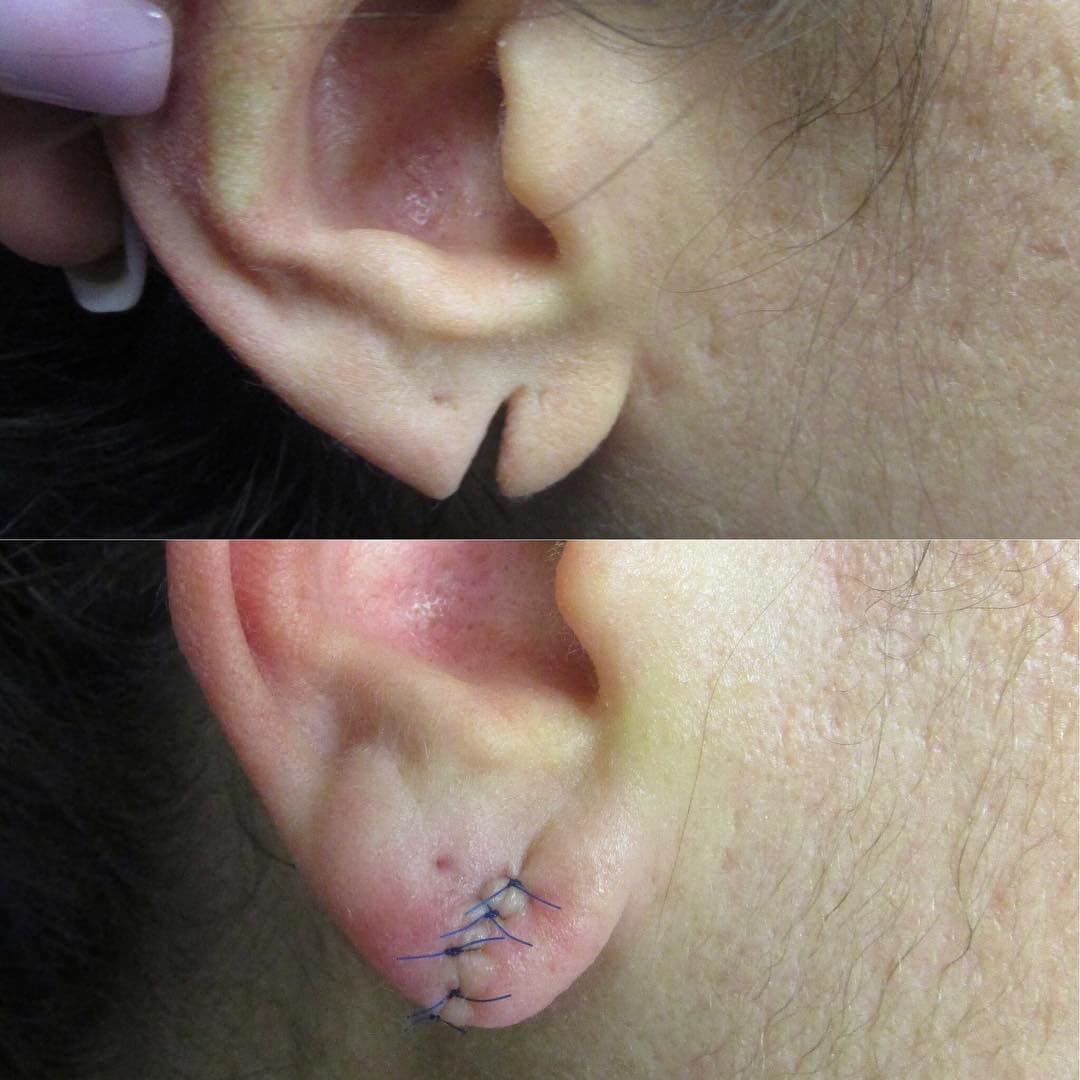Earlobe Repair Surgery in New York
Cosmetic surgery to repair a torn earlobe is a common procedure. Piercing an earlobe puts it at risk to tear when wearing heavy earrings over time. The size, style, and weight of an earring can contribute to the stretching of the earlobe opening. Large earrings that dangle can be caught on clothing or grasped by a child. The result may be a partially or completely torn earlobe. Repair of a torn earlobe occurs in plastic surgery or dermatologic surgery office setting using a local anesthetic. The procedure consists of “freshening” the edges of the split and placement of sutures to complete the repair of the earlobe. The final cosmetic outcome of your torn earlobe repair surgery is fully dependent on your surgeon’s skill set as well as his experience. Dr. Rokhsar is a double board certified dermatologic surgeon with over 20 years of experience repairing earlobes with thousands of happy torn ear lobe patients. Many doctors on the upper east side of Manhattan refer their torn ear lobe patients to Dr. Rokhsar for the best surgical outcomes. Dr. Rokhsar’s surgical results are often scarless. Dr. Rokhsar uses advanced suturing techniques to make the scars in the earlobe imperceptible.
Keloids are a common skin issue on the ear lobes for African Americans, Hispanics, and some Asian patients. Keloids are overgrown scar tissue in genetically susceptible individuals which present as firm nodules that can often be itchy or painful. Earlobe keloids can be either surgically removed or treated with Kenalog-5 FU steroid injections. Oftentimes, injections work great eliminating the need for keloid surgery. Dr. Rokhsar’s particular cocktail of steroid injection with 5FU injections resulted in swift resolution of keloids in a few injection sessions eliminating the need for surgery. Surgery may be required for unusually large ear keloids. Dr. Rokhsar often recommends to follow the earlobe keloid surgery with steroid injections to decrease the risk of the recurrence of keloids. Pressure earring worn after the surgery may also help your ear keloids not recur.

Torn Earlobe Repair Procedure
In most pierced ears, the pierced hole gradually enlarges over time after many years of wearing earrings. When the earlobe tears, the final tear is usually just through a tiny piece of tissue at the bottom of the lobe. Because of this, an immediate repair will not take care of the problem as new skin has already grown over the torn areas. This necessitates a surgical reconstruction which needs to be delayed until after the wound has fully healed and wound inflammation has subsided. However, if the tear starts from a tiny pierced hole, immediate earlobe repair1 is an option by Dr Rokhsar in his Long Island or Manhattan offices in New York. Depending on the deformity, reconstruction can take different forms. In all methods, the skin lining the slot is removed creating a raw edge to rebuild. When tissue has been lost, however, the procedure is more complicated, and reconstruction involves creating normal proportions around a somewhat small ear.
After Your Long Island Ear Lobe Repair Procedure
Dr. Rokhsar is a world expert in the surgical repair of torn earlobes. Immediately after your earlobe surgery, a pressure bandage is placed. The surgery is painless because Dr. Rokhsar skillfully will administer a numbing injection which you will barely feel. You will be instructed to change the bandage daily after washing your ear and cleaning it followed by application of an antibiotic ointment. Sutures are removed 1 – 2 weeks after the surgical repair procedure. A thin layer of antibiotic ointment is the only dressing applied in most cases. A little drainage from the wound is to be expected for one to two days. The recovery from ear lobe surgery is quick with minimal pain. Dr. Rokhsar performs hundreds of torn earlobe procedures every year.
For more information visit the Torn Earlobe and Torn Earlobe Surgery Pages.
Earlobe Repair FAQ
What is a split earlobe?
A Split earlobe often happens as a result of wearing an earring for periods of time which usually causes a slow tear of the ear lobe slowly. A split earlobe is the separation of the ear’s skin from the joint of an ear piercing down through the base of the earlobe and is covered by new skin. Heavy earring over a long period of time is the most common cause of a split earlobe. Loop earring or dangling earrings are more likely to cause a split earlobe than earring studs. Trauma is another common cause of earlobe splits.
How is a split earlobe repaired?
The most common and cosmetically elegant technique is a simple linear repair. This technique is performed under local anesthesia. It takes about 30 to 60 minutes to perform and it is painless. The area of earlobe repair is first numbed with lidocaine and epinephrine. This numbs the area quickly and also minimizes bleeding. The skin around the torn ear lobe is cut and freshened using a sharp surgical scalpel. Plastic surgery sutures are then used to bring the wound edges of the torn earlobe tightly together. The skill and suturing technique of the cosmetic surgeon is important in having a nice surgical outcome. This is a quick and effective in-office surgery performed to restore the earlobe. Sutures are usually removed 10-14 days later. A Z-Plasty technique is another method to reconstruct a torn or split ear lobe. This involves the wound being closed in a zig-zag fashion to strengthen the skin area from not splitting again. This technique is less preferred than linear earlobe repair by Dr. Rokhsar.
Are stitches required for ear lobe repairs?
After the wound edges are freshened with open skin, small sutures are stitched into the subcutaneous tissue on the surface of the skin, which can usually be taken out 10 to 14 days after the procedure. The sutures are very small and barely noticeable. Clear stitches can also be used within the split in order to minimize the appearance of the sutures. Dr. Rokhsar is an expert in the surgical repair of split or torn earlobes and has surgically repaired hundreds of patients.
How long does the earlobe repair surgery last?
The amount of time the procedure takes depends on the length of the split and the amount of trauma to the skin tissue. If there are complexities aside from just the split ear, there may be extra precaution and time required. In general earlobe repair takes about 30 minutes to one hour depending on the anatomy and particulars of the torn ear lobe. Dr. Rokhsar can repair torn ear lobes on both ears at the same time if desired by the patient.
Is earlobe repair painful?
Dr. Rokhsar’s earlobe repair is painless. Discomfort is minimal because Dr. Rokhsar uses a tiny needle to locally numb the area of the earlobe repair. Bleeding is also very little due to the use of epinephrine. After the numbing injection, the ear lobe repair procedure is completely painless. There is also no pain during recovery. Pain medications are not required after surgery. If there is any pain post-op after ear lobe surgery, Tylenol should suffice. Narcotics are seldom needed.
How soon can I wash my hair after surgery?
Right after the earlobe surgery there will be a pressure bandage placed on your ear. This dressing can be changed in 24 hours and the ear of the ear lobe repair can be gently washed with soap and water. This keeps the area clean. It also gets rid of any dried-up blood or debris. At this time, you can also wash your hair. You are encouraged to wash the ear lobe surgery area once a day and change the dressing. Therefore, your hair can also be washed daily while you are washing your ear lobe in the shower. Steri-strip is usually applied in our Manhattan and Garden city Offices immediately after your ear lobe surgery repair at the time of suture removal. It is recommended to shower and shampoo properly prior to your ear lobe surgery repair appointment. Once the stitches are removed, and steri-strips are applied, you can go about your daily routine without paying attention to the steri-strips. The steri-strips will fall off on their own usually 3- 7 days later. At 7 days, if they are still in place, you can gently peel them off.
How soon can I wear earrings after surgery?
You should wait one month after surgery before wearing earrings. Dr. Rokhsar often recommends creating a brand new hole using a piercing gun a month after the surgical ear lobe repair. This new hole will be nice and tight and will hold your earring tightly in the right place in the desired area of your earlobe matching your earring on the other side. The scar after surgery with Dr. Rokhsar is barely noticeable. We offer ear piercing service complimentary for our surgery earlobe surgery patients in both our Manhattan Upper East Side and Long Island Garden City offices in New York. If at any point the area of surgery forms any hard bumps, this could be the sign of the beginning of keloid formation. Dr. Rokhsar advises to start steroid injections immediately at the first sign of any hard bumps developing over the surgical area. For most patients, the area of the surgery will remain soft, which will allow you to get your lobe re-pierced approximately one month after the earlobe repair.
How much does earlobe repair cost?
The cost of earlobe repair can vary depending on several factors, including the type of ear lobe tear involved, if it is a full thickness tear, if earlobe reduction surgery is needed at the same time and overall extent of the surgery needed.
If you are interested in earlobe surgery, it is recommended to contact Dr. Rokhsar’s office, in the Upper East Side of Manhattan or Garden City Long Island to discuss cost and payment options.
New York Office Locations
Upper East Side Manhattan Office
121 East 60th Street, Suite 8AB New York, NY 10022
(212) 285-1110
Long Island Office
901 Stewart Ave, Suite 240, Garden City, NY 11530
(516) 512-7616
Request an Appointment
References
- Earlobe Surgery: What You Need to Know. Available: https://www.realself.com/surgical/ear-lobe-surgery.
- Cleft earlobe repair. Available: https://pubmed.ncbi.nlm.nih.gov/2316987/.



 Dr. Rokhsar was chosen by
Dr. Rokhsar was chosen by 






